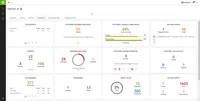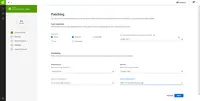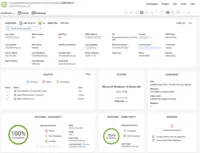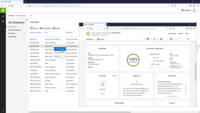Overview
What is ConnectWise Automate?
ConnectWise Automate, formerly LabTech, is a remote monitoring and management (RMM) platform. It provides powerful automation to discover and manage devices, monitor for problems, and scripts repetitive action.
ConnectWise Automate - Automate Everything
ConnectWise Automate was the right choice for us
It is a genuine remote Control.
ConnectWise Automate: The Robust RMM of Choice
Not For Small MSP
In My Opinion, Please, Don't Go with ConnectWise Automate Unless You Never Want to Reduce Your Client Count
ConnectWise Automate for MSP Management is an Excellent tool
ConnectWise Control - Great for Large Organizations
ConnectWise Automate - great all-round support and access tool
Automate Attraction
A fair RMM with some strong automation, but challenging to learn.
Automate Review
ConnectWise Automate
A Fantastic RMM That Stands Apart from the Competition
Automate Me, Baby!
Awards
Products that are considered exceptional by their customers based on a variety of criteria win TrustRadius awards. Learn more about the types of TrustRadius awards to make the best purchase decision. More about TrustRadius Awards
Popular Features
- Remote monitoring (21)7.272%
- Policy-based automation (21)6.969%
- Patch Management (20)6.060%
- Network device monitoring (20)5.151%
Pricing
Agents
$1.00-$6.00
Implementation Fee
$700
Entry-level set up fee?
- No setup fee
Offerings
- Free Trial
- Free/Freemium Version
- Premium Consulting/Integration Services
Product Demos
ConnectWise Automate Demo
Office365 For ConnectWise Automate - [Shell Console]
Active Directory UC for ConnectWise Automate
Office365 for ConnectWise Automate
Features
Monitoring Tasks
Various types of monitoring
- 7.2Remote monitoring(21) Ratings
Monitoring of network operational activities through the use of remote devices known as monitors or probes
- 5.1Network device monitoring(20) Ratings
Monitor the real-time performance and health of devices on your network
Management Tasks
Various tasks required to keep systems running smoothly
- 6Patch Management(20) Ratings
Patch management involves acquiring, testing, and installing multiple patches (code changes) to an administered computer system.
- 6.9Policy-based automation(21) Ratings
Policy-based management is an administrative approach used to simplify the system management by drafting rules to deal with common situations
Product Details
- About
- Integrations
- Competitors
- Tech Details
- FAQs
What is ConnectWise Automate?
- Discovery – Automatically deploy and detect the status of devices, creating accountability and access to all managed devices.
- Management – Providing access to each endpoint managed makes it easier to resolve issues fast and keep downtime to a minimum.
- Patching – Configures Windows patch management with out-of-the-box policies for Microsoft and third-party software.
- Automation – Automates repeatable tasks to decrease costs and also keeps techs happy by automating the tasks they hate doing.
ConnectWise Automate Screenshots
ConnectWise Automate Video
ConnectWise Automate Integrations
ConnectWise Automate Competitors
ConnectWise Automate Technical Details
| Deployment Types | On-premise, Software as a Service (SaaS), Cloud, or Web-Based |
|---|---|
| Operating Systems | Windows |
| Mobile Application | No |
| Supported Languages | Automate's Control Center is in English, Agents are compatible with all Windows supported Languages |
Frequently Asked Questions
Comparisons
Compare with
Reviews and Ratings
(205)Community Insights
- Business Problems Solved
- Pros
- Cons
- Recommendations
ConnectWise Automate is a powerful tool that is actively used by customers to support and monitor their networks and servers. With this platform, users are able to provide fast and efficient service by remotely managing all clients' computer systems and maintaining software. This includes managing endpoints, providing patch management, and remote monitoring/maintenance for clients. Users also leverage ConnectWise Automate as a comprehensive asset inventory, support ticketing, monitoring, and alerting tool. It allows for screen sharing access to assist end-users and manage servers remotely.
LabTech, another name for ConnectWise Automate, plays a crucial role in managing technology assets for multiple clients. The service department of organizations uses it to handle Windows patching, alerting, and remote access for clients' servers and workstations. LabTech ensures that client networks are efficiently managed by independently scanning and deploying agents, installing patches, and monitoring critical machines. Additionally, LabTech serves as an RMM platform for managing, automating, and maintaining customers' networks. It enables remote support, patch management, and remote monitoring while providing flexibility and multitenant architecture.
ConnectWise Automate has gained recognition for its ability to serve as a central point for end-user support and automation management. Its flexibility and multitenant architecture make it a valuable tool for managing, automating, and maintaining customers' networks. By offering features such as remote support, patch management, and remote monitoring, ConnectWise Automate empowers organizations to provide top-notch services to their clients while increasing efficiency in IT operations.
Tight Integration with Connectwise: Users have consistently praised the seamless ticket management and resolution that comes from LabTech's integration with Connectwise. Several reviewers found this aspect to be very tight, allowing for a smooth workflow between the two platforms.
Powerful Scripting Capabilities: Many users have highlighted LabTech's scripting capabilities as a standout feature. They appreciate its versatility and ability to automate mundane tasks. This has made their work more efficient and streamlined.
Effective Alerting System: Reviewers have mentioned that LabTech's alerting system is highly effective in notifying the on-call team of critical events while separating non-critical issues. This feature has been particularly valuable in ensuring timely responses to important incidents.
Confusing and Outdated User Interface: Many users have found Labtech's management system user interface to be confusing, outdated, and in need of updating. Some users have described it as unintuitive and difficult to navigate, making tasks more challenging to perform.
Steep Learning Curve for New Users: A significant amount of configuration is required out of the box for Labtech's software, which has led to a steep learning curve for new users. Some reviewers have mentioned that it can be intimidating and complex, requiring dedicated resources to fully leverage its capabilities.
Issues with Stability and Functionality: Users have experienced issues with the stability and reliability of Labtech's infrastructure when using cloud partners. Several built-in scripts, screens, and modules were reported not to work completely, indicating some problems with functionality.
Users recommend using the self-hosted version of ConnectWise Automate instead of the cloud version, particularly for companies with more than 500 employees. It is suggested to evaluate other products if support is a priority and to dedicate sufficient time to planning before implementing ConnectWise Automate. Users advise familiarizing oneself with all the software's capabilities and taking advantage of online courses to gain a deeper understanding. ConnectWise Automate is regarded as reliable with regular updates and excellent support, although there is room for improvement in its reliability. To ensure long-term success, it is recommended to set up ConnectWise Automate correctly from the start and to establish the appropriate configuration. Additionally, when comparing to other free RMMs, users suggest considering the cost and setup required for ConnectWise Automate.
Attribute Ratings
Reviews
(1-4 of 4)Every computer that we manage gets ConnectWise Automate installed on it, and it handles installing the rest of our tools stack and gets those machines assigned to the proper client with the proper settings for that client
- Alerting / Monitoring
- Process Automation
- Software Version Control
- Selective Targeting of Automations
- Patch Management - kind of clunky, but works well
- Reporting
- Endpoint user management
Patch Management works well, but the interface and deployment are clunky and have a steep learning curve. Once mastered, it handles patching very well, but navigation is not the easiest. Further, it comes with some decent canned reports, but generating custom reports is not well documented and very difficult. It used to be done using Crystal reports, and if you knew the database, you could generate very nice reports, but it has since moved to a custom report builder, and the nesting/grouping does not work well
- Scripting / Automation
- Monitoring / Alerting
- Automatic Remediation
- Software Version Control
- Security Features
- Remote monitoring
- 100%10.0
- Network device monitoring
- 70%7.0
- Patch Management
- 50%5.0
- Policy-based automation
- 90%9.0
- Positive - ConnectWise Automate allows us to provide eyes on critical machines 24x7, allowing us to sell ourselves as a 24x7 shop
- Automatic deployment of software allows for fast response to Client requests, earning us high marks every month/quarter in customer service from our clients and generating good references/word of mouth advertising
- The ability to deploy vulnerability scans at the click of a button allows us to sell additional security services and generate good data on vulnerabilities that can be repaired
I have also evaluated Addigy. While I think Addigy does a better job of managing apple devices, it is clunkier, and customization is harder in Addigy than in ConnectWise Automate.
Our Engineers and Service Desk use ConnectWise Automate for Computer Management, Computer Access, and detailed information
Our Development development team uses ConnectWise Automate for the Deployment of software, Monitoring, Alerting, and Process Automation.
All of our users have access to ConnectWise Automate and use most of the functions it has to offer
The wider the knowledge of IT roles, the more you will be able to use Automate to make processes easier to ConnectWise Automate and Manage (E.G., a solid understanding of Active Directory will allow you to use ConnectWise Automate to manage Client Active Directory environments, a solid understanding of Office 365, especially Powershell access, will allow you use ConnectWise Automate to manage Office 365 environments)
- Process Automation
- Monitoring / Alerting
- Software Deployment
- Patch Management
- We were able to configure ConnectWise Automate to deploy tools for a third-party security vendor to run penetration tests with a few clicks of the mouse via ConnectWise Automate. That vendor could then generate reports for actionable items that we can then remediate for HIPAA or NIST compliance, allowing us to be a one-stop shop for compliancy
- We were able to develop a Powershell script that sets a unique complex local admin account for all the machines we manage and store it in easily accessible tools that can be used for easy local admin access
- We were able to use ConnectWise Automate to pull all user e-mail addresses from Office 365 and insert them into Active directory if they did not already exist, and then run a sync tool between active directory and our CRM (ConnectWise Manage) that creates or updates contacts for each user in Active Directory (which now has valid E-mail addresses)
- We are currently investigating a way to ConnectWise Automate responses to security incidents (E.G., registry key removal for malicious software) based on reports from Huntress
- We are looking at using ConnectWise Automate for more direct Active Directory management so that changes can be made without needing to log into client servers for those changes
However, ConnectWise Automate is also completely capable of meeting all of our business needs and customizable to the point where if something is not meeting those needs out of the box, it can be modified to do what we want. From only installing software on machines if a different software package exists, to push a new version of that software is available, to check if credentials for user/machine have been updated to our new standards and then updating them if they have not, ConnectWise Automate is capable of doing everything we ask of it.
- Product Features
- Product Usability
- Product Reputation
- Don't know
- Online Training
I also strongly recommend setting up an internal "testing" group when making custom scripts, monitors, and automation to that you can ensure there are no unexpected results when rolling these out to clients
The customization is easy to perform, and each user can set their own custom tiles on the computer management screen, allowing each user to see the tiles that they are most likely to use. This is in addition to two static interfaces that have all the information available.
Additional fields can be created to allow for targeting things outside of the standard database.
It is not higher because they will not support more advanced custom configurations (like scripting or reporting) without an additional charge. I have found that going through the Certifications, I do not have much need for assistance with the unsupported items, and when I do, the questions I have can be phrased in a way that is supported because it is not a "How do I..." but a "this command in my script is not working as intended" type of question.
This is not a 10 because some of the interfaces are very clunky (Patch Management), and some features are not intuitive and not well documented (reporting). Scripting and Patch Management have a fairly steep learning curve (For structure in patch management and syntax in scripting), but once learned, they work well.
- Getting information about managed computers
- Credential storage
- Agent Configuration
- Monitoring / Alerting
- CANNED reporting
- Patch Management
- Custom Reporting
Pretty good product for small/mid MSPs
- The integration with screenconnect is my favorite. Being able to console in directly to a machine within a matter of a few clicks is great. Performance is better than teamviewer, logmein, Bomgar, join.me and vnc.
- Integration with third party products, such as Webroot or Shadow Protect. It has made deployments much easier to manage.
- Support. The support team at LabTech has always been great. They are always able to locate a knowledge base article or assist with an issue relatively quickly and resolve it just as fast.
- Patching. This used to work well, but since the 10.0 version forward, it has been lacking. Too often we have systems that don't patch and servers that don't reboot and manual intervention is needed.
- Reporting. Could use a lot of work. Even with going to Devexpress, we aren't seeing what we want for larger businesses and have to rely on creating our own reports through other tools.
- Support for third party products. I find a lot that if it isn't integrated to LabTech, the reporting on it lacks. Currently my biggest pet peeve, is how LabTech reports other antivirus statuses. Works great if it is Vipre, ESET or Webroot, but if you are using Trend, Symantec or something else, you don't get accurate data about version status or if it is up to date. Sometimes, it doesn't report an antivirus installed, even though it clearly is.
- As far as actual dollar amount would go, I couldn't tell you. However, as an admin, there is a lot of automation that does occur and does work well for us, so I could say that we do get a lot out of the product. There are a lot of small, administrative tasks that LT performs on the backend, that saves a lot of time. We rely less on people and more on the tool to handle NOC related issues.
LabTech, Managed or Not?
- Automation
- Customization
- Flexibility
- Managment
- Technical Support
- QA of new releases
- Communications with their customers
- Fewer human resources needed
- Occasional additional man hours needed for customization.
- Product grows as we do
- MAXfocus and N-Able
- Automation
- Inventory
- Day to Day Support
- Watching for Malware/Randsomware
- Automate work and billing for Break/Fix clients
- Deployment of Solutions
- More Automation and Resolution
- Migration Automation
- Better Reporting and Strategy Insight
- Price
- Product Features
- Product Usability
- Implemented in-house
- Understanding the inner workings of it
- How somethings related to others
- How other things would be effected by a change
- Online training
- Self-taught
All of that said, they are starting and trying hard to improve on support and I have seen a slow change. Most of these issues are due to a transistion of Support and hopefully will be resolved in the very near future.
- Remote Assistance
- Reviewing an Agents Status
- Executing an action
- Viewing some Delete repeated word
- Customization
- Setting up a new client with all of the correct settings and information
- Dashboard view is nice
- Better Patch Management
- Cleaner Look
- Improved Speed
- Improved UI
- Easier access to Data
Thoughts about LabTech
- Provides good, detailed information about computers' properties - running processes, installed software, hardware, networking, logs, etc...
- Provides simple, fast, and powerful remote access capabilities.
- Can be configured to automatically respond when certain behaviors occur on monitored computers. The possible responses are limited only by imagination.
- Has powerful scripting capabilities.
- The user interface is improving with new versions but is unintuitive and sometimes difficult to figure out.
- LabTech can save enormous man-hours of work through scripting & automation. If there is a task that must be repeated on multiple systems - pushing updates (Microsoft or 3rd party), or installing/uninstalling applications for example - then a LabTech admin can spend time *once* to configure LabTech to perform that action on all of the computers, and then the action can occur automatically. It isn't necessary for a technician to perform the action repeatedly for every managed computer.
- Kaseya
- Maintaining Microsoft & 3rd-party patches are up-to-date on managed systems
- Remote-access to user computers in order to help users having trouble.
- Deploy software without needing to send a technician to every workstation.
- We can analyze what hardware or software is in-use at client sites and generate reports, to suggest upgrades.
- We can have LabTech proactively alert us if a specific component or machine is failing, and automatically generate an email to an Acct Rep to quote out a replacement part.








